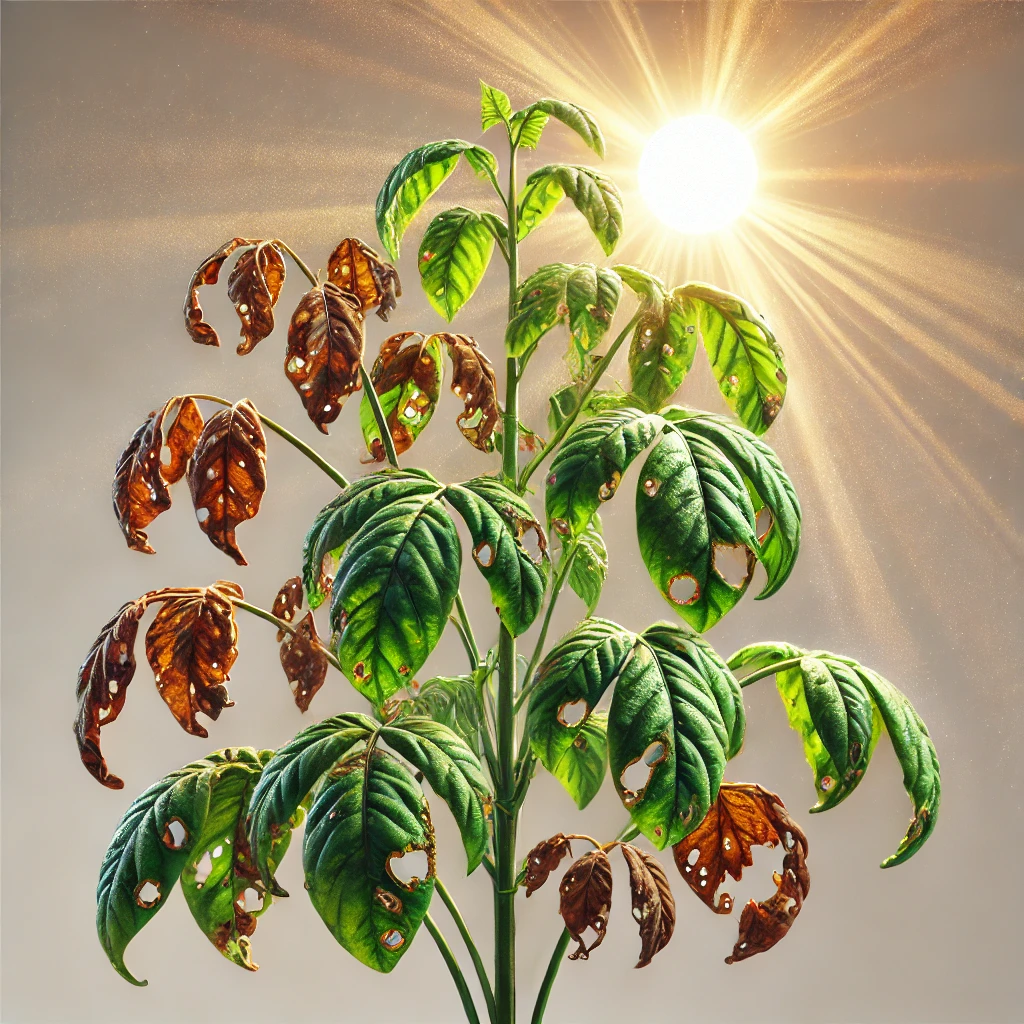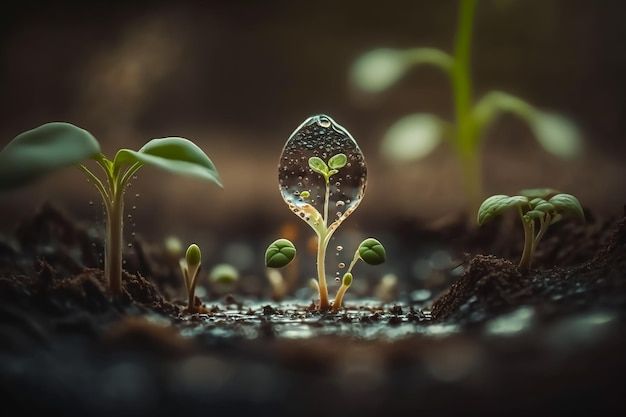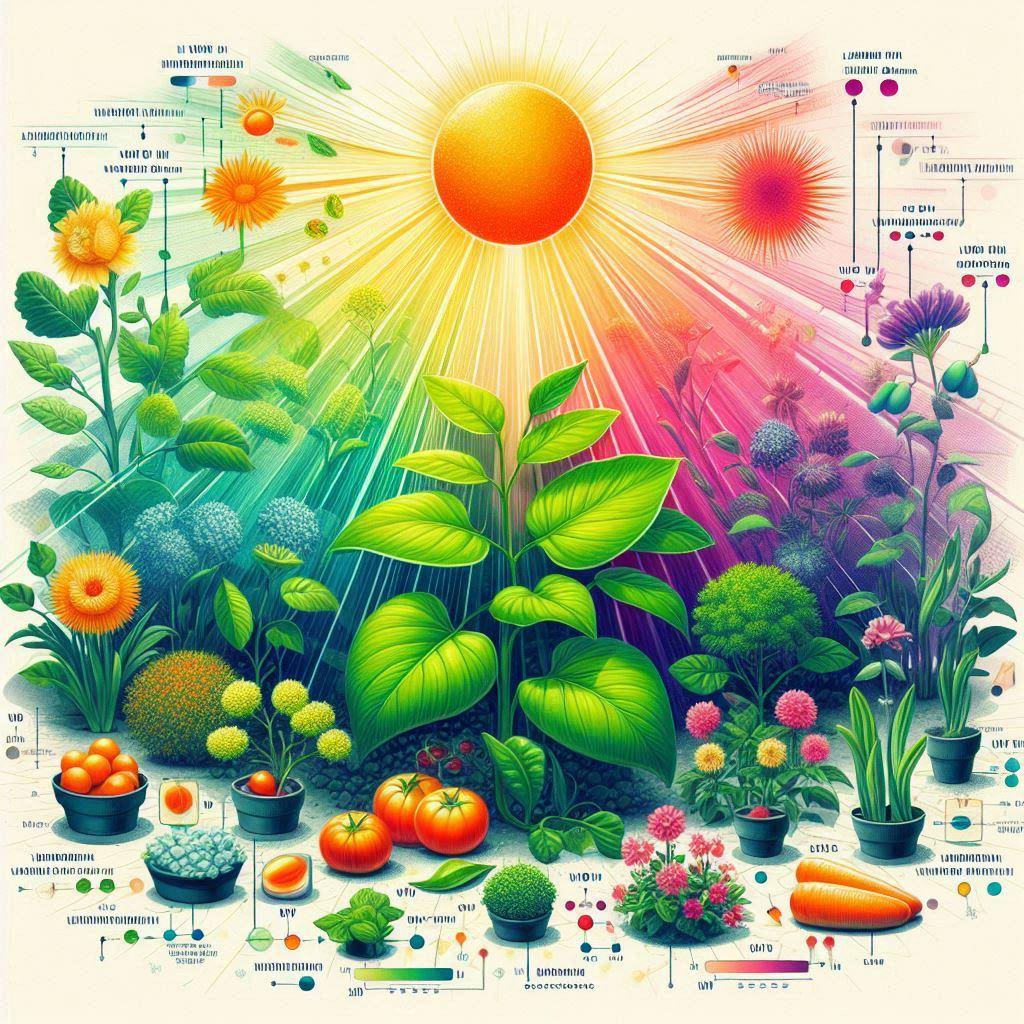Introduction
Ultraviolet (UV) radiation is a significant environmental factor influencing plant growth, development, and overall productivity. While plants have evolved natural defense mechanisms to cope with UV exposure, excessive radiation, particularly from UVB and UVC wavelengths, can lead to detrimental effects such as DNA damage, oxidative stress, reduced photosynthetic efficiency, and impaired growth. To mitigate these effects and improve agricultural productivity, researchers and agronomists are increasingly focusing on the use of UV-protective compounds to enhance crop resilience. These compounds, which include flavonoids, phenolic acids, carotenoids, and synthetic UV-protective formulations, serve as vital tools in shielding plants from harmful radiation while also offering additional benefits such as improved stress tolerance and pest resistance.
Flavonoids as Natural UV-Protectants
Flavonoids are among the most extensively studied natural UV-protective compounds in plants due to their remarkable ability to mitigate the harmful effects of ultraviolet radiation. These secondary metabolites play a vital role in plant defense, particularly against UVB radiation, which can induce oxidative stress, DNA damage, and cellular deterioration. Found primarily in the epidermal layers of leaves, stems, and flowers, flavonoids act as natural sunscreens, absorbing high-energy UV radiation before it can penetrate deeper into plant tissues. By limiting UV-induced cellular damage, flavonoids contribute to plant resilience, ensuring normal growth and development even in environments with elevated UV exposure.
One of the key features of flavonoids is their ability to absorb UV radiation while allowing the passage of photosynthetically active radiation (PAR), which is essential for plant energy production. This selective absorption ensures that plants can continue their normal physiological processes while shielding themselves from excessive UV stress. The biosynthesis of flavonoids is often upregulated in response to UV exposure, functioning as an adaptive mechanism that enables plants to withstand prolonged periods of radiation. This self-regulating process ensures that plants maintain optimal flavonoid concentrations based on environmental conditions, reducing the likelihood of overproduction, which could interfere with other metabolic functions.
Different types of flavonoids, including flavonols, flavones, and anthocyanins, contribute to UV protection in distinct ways. Flavonols such as quercetin and kaempferol are particularly effective in absorbing UVB radiation, reducing the formation of reactive oxygen species (ROS) that could lead to oxidative damage. These compounds are often found in higher concentrations in sun-exposed leaves, indicating their role in mitigating UV stress. Anthocyanins, another class of flavonoids, not only absorb UV light but also contribute to photoprotection by scavenging free radicals. Their accumulation in leaves, flowers, and fruits enhances stress tolerance while also playing a role in plant signaling and coloration.
The presence of flavonoids in plant tissues offers additional advantages beyond UV protection. Their antioxidant properties help neutralize free radicals that form under UV stress, preventing cellular damage and ensuring the stability of membranes, proteins, and nucleic acids. Additionally, flavonoids contribute to structural reinforcement by cross-linking with cell wall components, enhancing mechanical strength and further reducing UV permeability. This multifunctional nature of flavonoids makes them indispensable in plant defense strategies, allowing them to serve as both physical and biochemical shields against environmental stressors.
Flavonoids also play a crucial role in pest and pathogen resistance. Many flavonoid compounds exhibit antimicrobial properties that inhibit the growth of bacterial and fungal pathogens, reducing the likelihood of infection. Additionally, flavonoids act as deterrents to herbivorous insects by making plant tissues less palatable or even toxic to potential predators. This dual role of flavonoids as UV protectants and anti-herbivory agents highlights their importance in crop resilience, as they reduce the need for synthetic pesticides while enhancing overall plant health.
The agricultural significance of flavonoid accumulation has led to extensive research into methods of enhancing their production in crops. Traditional breeding programs have focused on selecting plant varieties with naturally higher flavonoid content, ensuring greater UV tolerance and stress resistance. Genetic modification techniques have also been employed to manipulate key enzymes in the flavonoid biosynthetic pathway, leading to crops with enhanced flavonoid accumulation. For example, transgenic maize and wheat lines with upregulated flavonoid synthesis genes have demonstrated increased UV protection and improved resistance to oxidative stress. Advances in biotechnology, including CRISPR-Cas9 gene editing, hold promise for further optimizing flavonoid production, allowing for precise modifications that enhance plant resilience without negatively impacting growth or yield.
In addition to genetic approaches, agronomic practices such as controlled UV exposure, nutrient supplementation, and elicitor treatments have been explored to stimulate flavonoid synthesis in crops. Studies have shown that moderate UVB exposure during early growth stages can induce flavonoid accumulation, priming plants for enhanced tolerance later in development. Similarly, applications of elicitors such as salicylic acid and jasmonic acid have been found to boost flavonoid production by activating stress-response pathways. These strategies offer sustainable solutions for improving crop resilience in the face of increasing UV radiation due to climate change and ozone depletion.
Phenolic Acids and Their Role in UV Protection
Phenolic acids are an essential class of secondary metabolites in plants, serving as potent UV-protective compounds that mitigate the adverse effects of ultraviolet radiation. Structurally, phenolic acids are derived from the phenylpropanoid pathway and exist in both free and conjugated forms, allowing them to participate in a range of physiological and biochemical processes. Like flavonoids, phenolic acids contribute to plant defense by absorbing harmful UV radiation, reducing oxidative stress, and reinforcing cellular structures. These compounds are particularly important in plants exposed to elevated UVB radiation, as they help maintain cellular integrity and overall plant health.
One of the primary mechanisms by which phenolic acids provide UV protection is through their ability to absorb and dissipate UV radiation. Specific phenolic acids, such as ferulic acid, caffeic acid, and sinapic acid, exhibit strong UV absorption properties, particularly in the UVB range. These compounds are commonly found in plant epidermal tissues, where they act as a protective barrier against excessive radiation. By absorbing UV light before it penetrates deeper into plant tissues, phenolic acids reduce the likelihood of DNA damage, protein denaturation, and membrane disruption. This UV-filtering effect plays a crucial role in maintaining normal cellular functions under high-radiation conditions.
Beyond their role as UV absorbers, phenolic acids are also highly effective antioxidants. UV radiation exposure leads to the formation of reactive oxygen species (ROS), which can cause oxidative damage to lipids, proteins, and nucleic acids. Phenolic acids neutralize these harmful free radicals, preventing the accumulation of oxidative stress and reducing cellular damage. Their antioxidant properties are particularly beneficial in chloroplasts, where they help maintain photosynthetic efficiency despite UV-induced stress. Additionally, phenolic acids work in synergy with other antioxidant molecules, such as flavonoids and carotenoids, to enhance overall plant resilience.
Another significant function of phenolic acids in UV protection is their role in strengthening cell walls. These compounds contribute to the formation of lignin, a complex polymer that provides structural rigidity and enhances plant durability under stressful conditions. Lignin synthesis is particularly important in response to UV exposure, as it reinforces plant tissues against potential degradation. Ferulic acid, for example, is a key component of lignin cross-linking, helping to form a robust structural matrix that limits UV penetration and minimizes damage to underlying cells. By reinforcing cell walls, phenolic acids not only improve UV tolerance but also enhance resistance to other environmental stressors such as drought and pathogen attacks.
The agricultural application of phenolic acids has gained increasing attention due to their ability to enhance crop resilience in high-UV environments. Several agronomic strategies have been developed to boost phenolic acid accumulation in crops, including soil amendments, foliar sprays, and genetic manipulation. Research has shown that supplementing soil with organic matter rich in phenolic precursors can promote the biosynthesis of these compounds in plants. For instance, compost and biochar applications have been found to increase ferulic acid and caffeic acid levels in crops such as wheat and rice, leading to improved UV protection.
Foliar applications of phenolic-rich plant extracts have also demonstrated promising results in increasing UV tolerance in leafy vegetables such as lettuce and spinach. These treatments not only enhance the accumulation of UV-protective phenolic acids but also improve the nutritional quality of the crops by boosting their antioxidant content. Additionally, elicitor treatments using natural plant hormones and signaling molecules, such as salicylic acid and jasmonic acid, have been shown to induce phenolic acid production as part of the plant’s stress response mechanism.
From a biotechnological perspective, genetic engineering approaches have been explored to enhance the biosynthesis of phenolic acids in crops. By upregulating key enzymes involved in the phenylpropanoid pathway, researchers have successfully developed transgenic plants with higher levels of phenolic acids, resulting in increased UV resilience. Advances in genome editing technologies, such as CRISPR-Cas9, provide further opportunities for precise modifications that enhance phenolic acid production without compromising plant growth and yield.
Carotenoids as Dual Function UV-Protectants
Carotenoids are a diverse group of naturally occurring pigments that serve a critical dual function in plant defense against ultraviolet (UV) radiation. These compounds, including beta-carotene, lutein, and zeaxanthin, are vital components of the photosynthetic system and play a significant role in protecting plants from excessive radiation exposure. Their dual functionality arises from their ability to both absorb and dissipate harmful UV radiation while simultaneously acting as powerful antioxidants that mitigate oxidative stress. This unique combination makes carotenoids essential for plant survival in high-UV environments and valuable targets for agricultural enhancement.
One of the primary protective roles of carotenoids is their involvement in light energy dissipation through a mechanism known as non-photochemical quenching (NPQ). During high light and UV exposure, excess energy absorbed by chlorophyll molecules can lead to the generation of reactive oxygen species (ROS), which cause oxidative damage to proteins, membranes, and DNA. Carotenoids, particularly zeaxanthin and lutein, participate in NPQ by safely converting surplus energy into heat, preventing overexcitation of the photosynthetic machinery. This process ensures that plants can maintain efficient photosynthesis even under stress conditions, thereby sustaining growth and productivity.
In addition to their role in NPQ, carotenoids contribute to UV protection by absorbing radiation within the 400–500 nm range, shielding plant tissues from excessive light exposure. Although they are not as effective at directly absorbing UVB radiation as flavonoids and phenolic acids, carotenoids help reduce UV-induced damage indirectly by stabilizing chlorophyll molecules and preventing photobleaching. This stabilization ensures that the photosynthetic system remains functional, even under prolonged UV stress.
The antioxidant properties of carotenoids further enhance their protective capacity against UV damage. Beta-carotene, for example, is highly efficient at scavenging singlet oxygen molecules and neutralizing free radicals that form due to UV exposure. By reducing oxidative stress, carotenoids help maintain membrane integrity and cellular homeostasis, which is crucial for plant survival in extreme environments. The ability of carotenoids to interact with other antioxidant molecules, such as tocopherols (vitamin E) and ascorbic acid (vitamin C), creates a synergistic defense system that enhances overall stress tolerance.
Beyond UV protection, carotenoids also contribute to plant adaptation to other abiotic stressors, such as drought and high temperatures. Plants with higher carotenoid concentrations tend to exhibit improved resilience under harsh environmental conditions, as these pigments support membrane fluidity, enhance water retention, and reduce the impact of oxidative stress caused by heat and desiccation. This multifunctionality highlights the importance of carotenoid accumulation not only in natural plant survival strategies but also in agricultural production systems.
In recent years, there has been increasing interest in enhancing carotenoid levels in crops through biofortification strategies. Golden rice, one of the most well-known examples of carotenoid-enriched crops, has been genetically engineered to produce higher levels of beta-carotene, not only improving its nutritional value but also increasing its tolerance to environmental stressors. Similarly, biofortified maize varieties with elevated lutein and zeaxanthin levels have demonstrated enhanced resistance to UV stress, drought, and heat, showcasing the potential of carotenoid-boosting strategies for improving crop resilience.
Agricultural practices aimed at increasing carotenoid accumulation include genetic modification, selective breeding, and environmental manipulation. Traditional breeding programs have successfully developed crop varieties with naturally higher carotenoid content, providing a non-GMO approach to improving stress tolerance. Additionally, the application of phytohormones such as abscisic acid (ABA) and light treatments, including exposure to specific wavelengths, has been shown to stimulate carotenoid biosynthesis in plants. These techniques offer sustainable ways to optimize carotenoid production, ensuring that crops are better equipped to withstand changing climatic conditions.
As climate change continues to intensify UV exposure and environmental stressors, the role of carotenoids in crop resilience becomes increasingly vital. Their dual function as UV-protectants and antioxidants not only safeguards plant health but also improves agricultural productivity by reducing yield losses associated with abiotic stress. Harnessing the protective power of carotenoids through targeted breeding, biotechnological advancements, and optimized agronomic practices presents a promising avenue for sustainable food production in a rapidly changing world.
Synthetic and Bioengineered UV Protectants
In addition to naturally occurring UV-protective compounds, synthetic and bioengineered UV protectants are rapidly emerging as innovative solutions to enhance crop resilience against ultraviolet radiation. Traditional methods of UV protection in plants rely on endogenous secondary metabolites such as flavonoids, phenolic acids, and carotenoids. However, advancements in material science, nanotechnology, and genetic engineering have paved the way for novel approaches that provide more effective, long-lasting, and scalable protection. These synthetic and bioengineered protectants offer a promising avenue for improving agricultural productivity, especially in regions experiencing increased UV radiation due to climate change and ozone depletion.
One of the most exciting developments in synthetic UV protection is the use of nanoparticle-based UV-blocking formulations. Materials such as zinc oxide (ZnO) and titanium dioxide (TiO₂) have been widely studied for their ability to absorb and scatter harmful UV radiation while allowing photosynthetically active radiation (PAR) to reach plant tissues. These nanoparticles, when applied as foliar sprays or coatings, form an ultra-thin, transparent barrier on plant surfaces, significantly reducing UV-induced stress. Unlike conventional chemical UV protectants, which degrade over time and require frequent reapplication, nanoparticle-based protectants exhibit remarkable stability, adhering to leaf surfaces for extended periods and providing prolonged UV shielding.
Zinc oxide nanoparticles (ZnO NPs) are particularly effective due to their broad-spectrum UV absorption properties. They have been shown to reduce UV-induced chlorophyll degradation, mitigate oxidative stress, and even enhance photosynthetic efficiency in some plant species. Additionally, ZnO nanoparticles possess antimicrobial properties, offering a dual benefit of UV protection and disease resistance. Similarly, titanium dioxide nanoparticles (TiO₂ NPs) function as powerful UV filters and have been successfully used in multiple agricultural studies to enhance plant tolerance to UV stress. By optimizing particle size and formulation methods, researchers are working to maximize the efficacy of these nanomaterials while ensuring minimal environmental impact.
Apart from inorganic nanoparticles, organic UV-absorbing compounds such as synthetic flavonoid analogs and polymer-based UV protectants are also being explored. Scientists have developed bioinspired UV-absorbing molecules that mimic the properties of natural flavonoids but offer higher stability and longer retention on plant surfaces. Some synthetic polymers have been designed to selectively filter UVB and UVC radiation while permitting the penetration of visible light, thereby maintaining optimal growth conditions for plants. The application of such materials could revolutionize UV protection in agriculture, providing farmers with cost-effective and durable solutions to safeguard crops from radiation-induced damage.
Beyond external applications, bioengineering strategies are being employed to develop plants with intrinsic UV resistance. Genetic modification techniques have been used to upregulate the biosynthesis of key UV-protective compounds, such as flavonoids, phenolics, and carotenoids, within plant tissues. By enhancing the expression of specific genes involved in the phenylpropanoid and carotenoid biosynthetic pathways, researchers have successfully developed transgenic plants with superior UV tolerance. For instance, overexpression of transcription factors such as MYB12, which regulates flavonoid biosynthesis, has led to increased accumulation of protective compounds in model plants like Arabidopsis and tobacco. Similar strategies are now being explored for major crops, including maize, rice, and tomatoes.
CRISPR-Cas9 gene-editing technology has further accelerated advancements in bioengineered UV protection. Unlike traditional genetic modification techniques, which involve introducing foreign genes, CRISPR allows for precise editing of native plant genes to enhance UV resilience. Researchers have successfully used CRISPR to modify regulatory elements of flavonoid and phenolic biosynthesis pathways, leading to increased production of these compounds without negatively affecting plant growth. Additionally, gene-editing approaches have been used to enhance the expression of stress-responsive proteins, such as heat shock proteins and DNA repair enzymes, further strengthening plants’ ability to cope with UV-induced damage.
Another promising bioengineering approach is the development of symbiotic relationships between plants and UV-resistant microorganisms. Certain strains of endophytic and rhizospheric bacteria have been found to enhance plant UV tolerance by inducing the production of protective metabolites. For example, plant-associated bacteria that naturally produce antioxidants and UV-absorbing compounds can be introduced into crop systems to bolster UV resilience. Such microbial-based strategies provide a sustainable and environmentally friendly alternative to synthetic UV protectants, reducing the reliance on chemical treatments.
While synthetic and bioengineered UV protectants hold immense potential for modern agriculture, challenges remain in their large-scale implementation. Concerns about the environmental impact of nanoparticles, regulatory hurdles surrounding genetically modified crops, and the economic feasibility of advanced UV-protection technologies need to be addressed. However, ongoing research and technological innovations continue to refine these strategies, making them more efficient, sustainable, and accessible for farmers worldwide.
Applications in Greenhouse and Controlled Environments
The application of UV-protective compounds extends beyond field crops and is particularly valuable in controlled environments such as greenhouses and vertical farms. In these settings, where artificial lighting and UV exposure can be precisely managed, the strategic use of UV-absorbing compounds helps optimize plant growth while reducing stress-related productivity losses. Certain commercial greenhouse films and coatings are also designed to incorporate UV-blocking properties, thereby minimizing harmful radiation while still allowing beneficial wavelengths for plant development. By combining these materials with natural or synthetic UV-protective compounds, growers can create an optimal environment for high-yield, high-quality crop production.
Challenges and Future Prospects
Despite the numerous benefits associated with UV-protective compounds, challenges remain in their widespread adoption. One of the primary concerns is balancing UV protection with the need for UV-induced beneficial effects, such as increased secondary metabolite production and pathogen resistance. Overuse of UV-blocking strategies could potentially limit these positive responses, necessitating a careful, species-specific approach. Additionally, the cost of developing and implementing synthetic UV protectants, especially in large-scale farming operations, requires further research to ensure economic feasibility.
Future research in this field is likely to focus on optimizing the use of UV-protective compounds through integrated approaches that combine genetic, chemical, and environmental strategies. Advances in molecular breeding and genome editing techniques, such as CRISPR-Cas9, offer new possibilities for enhancing natural UV resilience in crops without compromising growth or yield. Additionally, sustainable formulations of UV-protective sprays using biodegradable and eco-friendly materials are being explored to reduce the environmental impact of synthetic chemicals. As climate change continues to alter global UV radiation patterns, the demand for effective UV-protective strategies in agriculture will only increase.
Conclusion
UV-protective compounds play a crucial role in enhancing crop resilience by mitigating the harmful effects of excessive radiation while promoting stress tolerance and overall productivity. Whether through natural plant metabolites like flavonoids, phenolic acids, and carotenoids or through synthetic and bioengineered UV protectants, these compounds offer promising solutions for sustaining agricultural yields in the face of environmental challenges. Ongoing research and technological advancements will continue to refine these strategies, ensuring that farmers can harness the benefits of UV protection to cultivate healthier, more resilient crops in an increasingly unpredictable climate.










